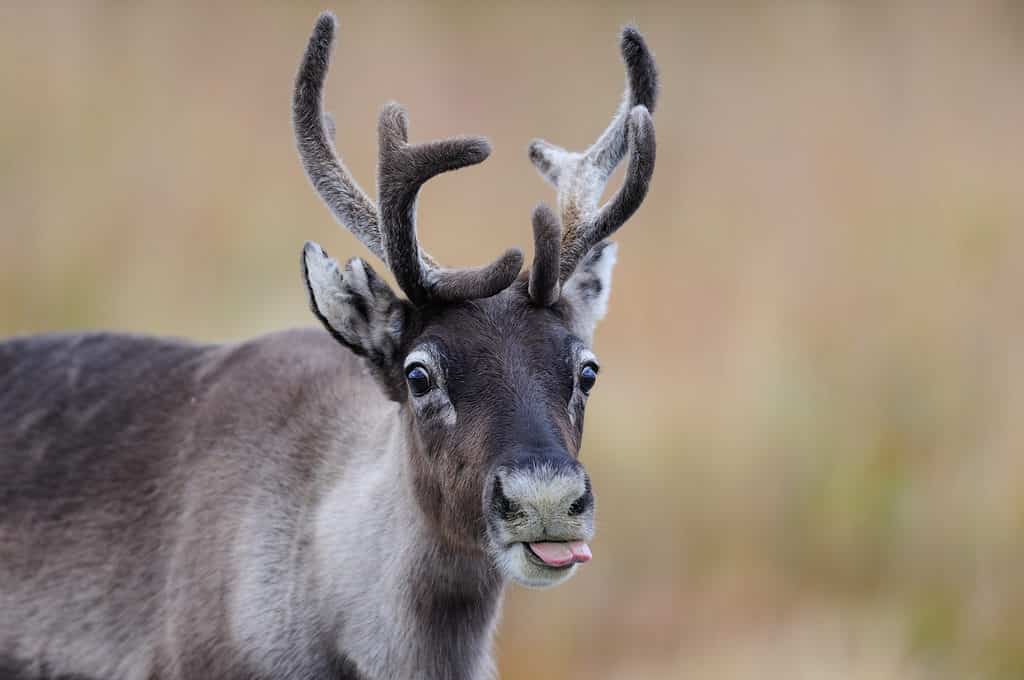Many people picture reindeer’s personalities to be similar to Santa Claus’s reindeer, and for the most part, they are not wrong. Reindeer are very friendly and welcoming animals that have helped humans in many ways for thousands of years. From simple companions to sled-pullers, reindeer are still used for many things today.
In this article, we’ll tell you how humans relate to reindeer, how friendly they are, and how they’re generally used worldwide. Let’s get started!
Are Reindeer Friendly?

©MM.Wildlifephotos/Shutterstock.com
The term reindeer typically refers to domesticated varieties of the animal. However, it can also refer to wild reindeer of Eurasia. The term “caribou” is preferred when talking about wild American reindeer. They are pretty friendly to humans, and one significant factor behind this is the fact that they are herbivores. If there’s one thing you can be sure of, it’s that reindeer will not try to eat you.
This is more than can be said about most other animals that inhabit the North Pole or other freezing regions of the world. Polar bears, for example, tend to attack and sometimes eat humans, especially when hungry, and most other animals there are scary in one way or another. In this manner, reindeer stand out as true friends among foes.
The Domestication of Reindeer
Moreover, there are many examples of reindeer domestication through the centuries. Its thought that the first people to domesticate reindeer were the native Nenets of Siberia about two thousand years ago. However, reindeer also serve ritualistic purposes as symbols, for example, of the changing seasons. This is due to their seasonal migrations, which can join together over 400,000 reindeer in enormous, field-covering groups.
The Sämi people of Scandinavia are a beautiful example of this. They’ve been herders of reindeer for thousands of years. In fact, in some countries in that region, herding reindeer is outlawed for everyone except them. Domesticating reindeer is a great move if you live near the North Pole, as they can provide everything a human needs to survive — food, clothing, and materials to make tools, to name a few. The Sämi people also have rituals related to reindeer migrations and have been practiced for ten thousand years. Reindeer naturally dominate the landscape in their native regions.
Additionally, reindeer are symbols of unity and self-actualization for many cultures and countries. In Canada, for example, there is a huge reindeer culture, and as expected, the animal is closely related to Christmas and Santa Claus. This shows that reindeer are fantastic animals and a big part of many people’s lives.
So, are reindeer friendly? Short answer: yes, they are! Long answer: yes, and some cultures throughout the centuries have taken a step further and incorporated them into their everyday life.
How Are Reindeer Used in Real Life?

©MARISINA/Shutterstock.com
Reindeer are heavily used for pulling sleds. In fact, very old, 1800-year-old Chinese manuscripts talk about domesticated reindeer, and Marco Polo even mentioned them over a thousand years later. Although they are tough to ride, some communities use them like we use horses. This is true of all Northern people that made use of this animal. After all, they’re a powerhouse of strength and endurance and have such adaptability that using them is an obvious advantage in harsh climates.
Additionally, they act as ample food and nutrition sources, as not only can their meat be eaten, but there is also evidence that humans used to milk reindeer like cows. Furthermore, clothing made of their incredibly dense fur is highly regarded and sought-after, as they have special adaptations in their skin that allow them to survive the cold winter.
There are also some more esoteric uses for them. For example, in much of Asia, their antlers, once shed, are crushed and sold as aphrodisiacs. But for the most part, they have been used for things that make sense if you live in the Arctic, as is the case with the Nenets, which use them as guides during snowstorms or river crossings. This is because reindeer have evolved special hooves that change with the seasons.
During summer, reindeer’s hooves become more padded and soft, allowing them to walk better on grass and soil. However, as winter approaches, they become harder and thicker, ideal for walking on ice sheets and frozen surfaces. Thanks to these adaptations, they have an innate sense of when ice is safe to walk on and when it’s going to break, and herders wisely follow them. If a reindeer hesitates before crossing, they trust nature and find another path.
Up Next…
- 10 Incredible Reindeer Facts
- The 10 Largest Deer in the World!
- Where Do Reindeer Live?
- Reindeer vs. Whitetail Deer: The 7 Main Differences
The post Are Reindeer Friendly? Discover How They’re Used in Real Life! appeared first on AZ Animals.
from Animal News, Facts, Rankings, and More! - AZ Animals https://ift.tt/FuWdk1X